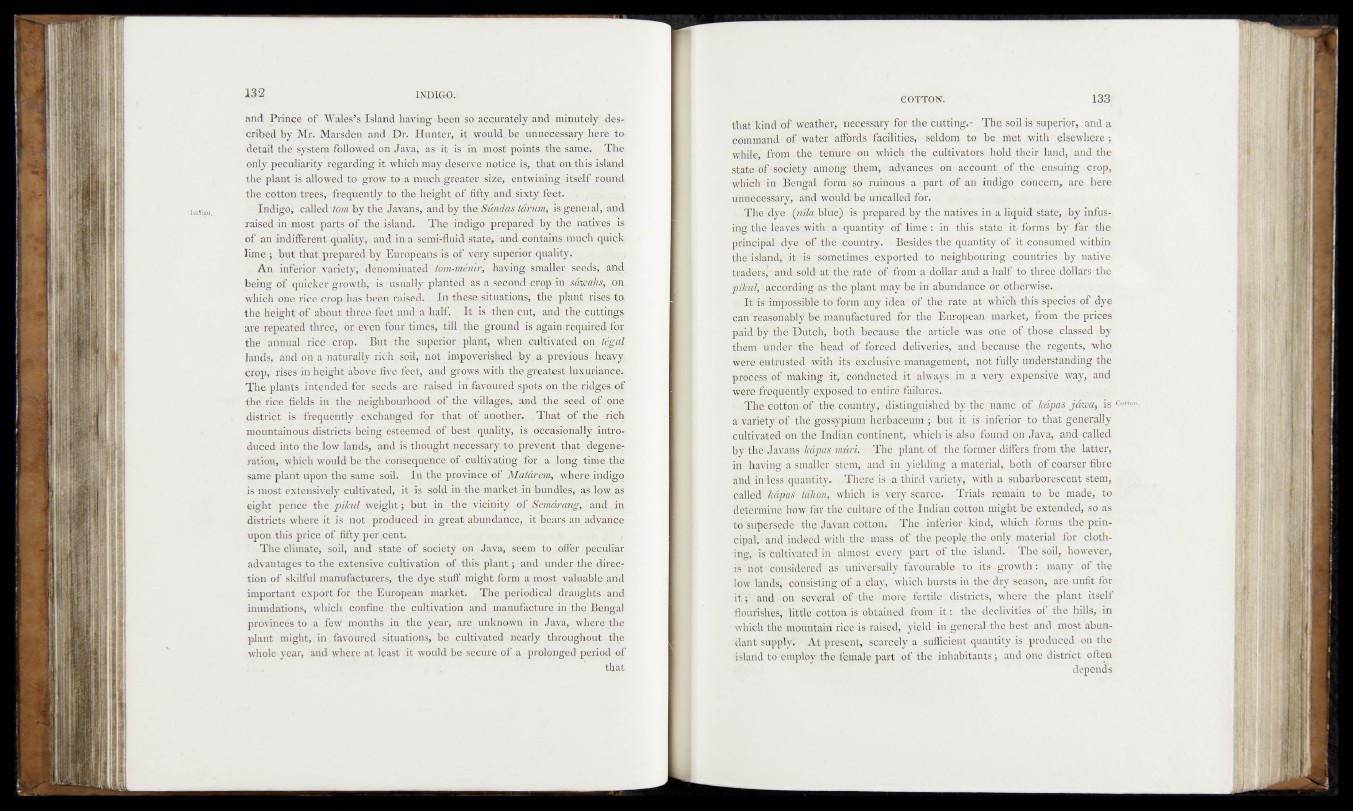
and Prince of Wales’s Island having beerf so. accurately „and minutely' described
by Mr. Marsden and .Dr. . Hunter, i t . would .be,-.unnece.ssary -.here to-
detail the system followed on Java, as it is ini most points/the same. .The
only peculiarity regarding it which may deserve.,notice is, that on this island
the plant is allowed to grow to a much greater, size, entwining, itself round
the cotton trees, frequently to the (.height of fifty and.sixty feekuL
-Indigo, called tom by the, Javans, and by .the.$w»das tarum, is. general,‘and.
raised in most parts of the island. The ".indigo prepared by the natiye^is
of ah indifferent quality, and. in a semi-fluid state, and.contains.much quick
lime; but that prepared by Europeans.is of very, superior .quality.
An inferior variety, denominated tom-menir, having smaller^se^ds,^.and
being of quicker growth, is -usually planted as a,second crop in safw'qhs,'^on
Which one rice-crop hap been raised. In these .situations,' the.:plant :rises jtq,
fhe-heightof about-three feet.and a half. i It,is then-cut,..and..the, cuttings
are repeated three, or-eveii four times, till the ground is agaift, req.uked3fpj
the annual rice - crop, j 'But the superior plant, when cultivated.
lands, and on a. naturally rich soil/not impoverished by. a previous ;.heavy,
crop, rises in height above five feet, and grows with the gr'eatest-lux^jaqce.
The plants intended for seeds are raised in favoured spots ojythe ridges of
the rice fields in the neighbourhood of the villages,, apd .theyseedj of .-One
district is frequently exchanged for that ;of another. . That of ;the .rich
mountainous districts being‘esteemed ,of. best ^quality, is. t occasionally! intjor
duced into the low lands, and Is thought necessary, to^pieyent. that^dqgene;
ration, which would be-the consequence of,cultivating .for a long,lime,the
same plant upon the same soil. In'the provincemf Matarem, ^yhererindi-go
is most extensively cultivated, it is. sold in - the -market in bundleSj.. as l,pw,as
eight pence the.pikul weight; but in the. vicinity o f ,Sem^rang,. and..in
districts where it is not produced in great abundance,. it bears an advance
upon this price of fifty per c e n t..
I . The climate, soil, and. state ,of.society on Java, seem, to !offer peculiar
advantages to the extensive cultivation of this .plant and ,qnder the.direc;
tion of skilful manufacturers, .thei.dyq stuff might form a .most ^ajuabje ;and
important; export for the European market. ; .The, periodical; draughts and
inundations, which confine, the cultivation and, manufacture infhe, Bengal
provinces to a few months in the year, are, unknown in Java,; where the
plant might, in . favoured situations, be cultivated nearly throughput. tfee
whole year, and where at. least it would be secure of a prolonged period of
■ 1 1 ‘ that
that kind of weather,' necessaryffor: the cuttings .The soilis superior, and »
command('oftwater.!affords 'facilities, seldom to, be , met with ■ elsewhere ;
from. fie tenur’êo.on ; which -the cultivators : hold ;their land, • and the
state rof; society amQh^*Uhem|^advancesirÖh/mecouixtj' pf the ensuing crop,, .
which1 in Bengal form*so> ruîâoùs.a part'.of an indigo'concern, are here
unnecessary, ' and whuldfbeUncalled^Fôr§ÿf'
• iThe/dyMpi^, blfie) is prepared by the natives in a liquid state, by infusing!
the Jeaves«;with a quantity Tof lime : in this state.;it forms, by -far thej
principal' dyeTof.’the." country. 3 Besides the quantity tp£, it consumed within
tifetisfend, itiris 'sdmetimes-Cexported to neighbouring countries by native
teasers*'" and sèlchatethe rate ofrfrom a dollar,and a half to three dollars the
pi'Bûl;vjàk'eô/dmg as the plant may. bëiiti-, abundance-.or otherwise. -
It is impossible' to‘form*'any idea' of !the; rate >atr which this species of dye
carrir bas on ably be manufactured for .-the. European market, from the prices
paid bythC^Utteh/ both because-'the article !was one; of those , classed -by
Ifc^î^edeTf thei/headiyaSTorcedn deliveries,' and, because thejrqgenfs, who
#éfeJéntrust''edy\vith ' its? exclusive ■ m anagemen t, not. fully understanding the
pr'0Cesgtoffmaking conducted-it always in a very, expensive way, and
were,frequentlyfwpb$‘edr.to entire failures.,.'- s
- The cotton, "of rthemountry,'- distinguished by the name of Jcâpas jâwa, is
a-vârietÿfofi’i the gossypium, herbaceum but it is inferior to that, generally
GuMivated on the Indian continent, which is also found on Java, and called
b^th eî J a Veins.'Aopâà mûri. t-.The plant of the former differs from the latter,
inrfhayiqg a;smaller stem, and in yielding a material, both, of coarser fibre
'and in>less;quantity. . There-is a third .variety, with a subarborescent stem,
called kâpas'tabon, which 'i s -vë^y? scarce. Trials remain to fee made, to
•dêt%rïhiïié'hoW' far the culture ofjthe Indian cotton might be extended, so as
to supersede ’th§ Javan'catton.' The inferior kind, which forms the principal’,''
add indeed with the mass of the people, the only material fpr clothing/
is 'cultivated in almost:every-part-of the island. : The soil, however,
is not considered as. universally favourable, to its growth: many of the
low landsj consisting of a clay, which bursts in the dry season, are unfit for
•it; and on several of the more fertile r districts,, where- the- plant itself
flourishes, “ little!cotton!is- obtained. from' it : the declivities of the hills, in
1 which the mountain rice is raised, yield in general the best and most abundant
supply.' ' At present,, scarcely a sufficient quantity is produced on the
island to employ the female part of the inhabitants ; and one district often
depends
Cotton.